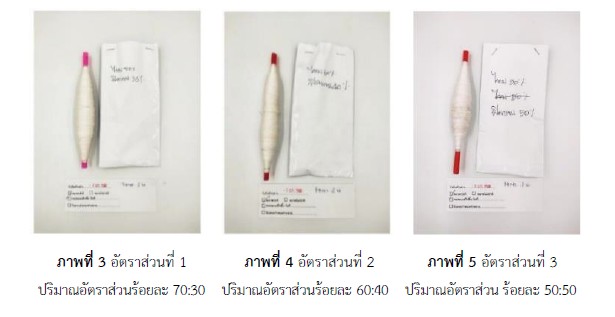Development of Blended Yarns between Silk and Filagen Fibers
Main Article Content
Abstract
The objectives of this research are: 1) to study the method of producing blended yarn with silk and filagen fibers; 2) to study the properties of blended yarn with silk and filagen fibers. The blended yarn was produced with silk and filagen fibers in 5 ratios, namely 70:30, 60:40, 50:50, 40:60, and 30:70 percent, and experts selected 3 ratios of blended yarn to produce sample yarns. These blended yarns were then tested with a tensile testing machine (INSTRON MODEL 5566) to test the tensile strength and elongation at break according to the standard ISO 2026:1993 (E) method A. In addition, the size of the yarn was measured according to the standard based on ISO 2060:1994 (E) option 1. The test was done using a test speed of 250 mm per minutes, and the test distance was performed at 250 millimeters. The results showed that the blended yarn using a ratio of silk and filagen fibers of 70:30 percent had a tensile strength at break of 14.97 newtons, elongation at break of 11.12 percent, and the size of the yarn was 574.7 denier. Therefore, this blended yarn is classified as a heavy type yarn, which is most suitable for developing prototype blended yarns between silk and filagen fibers.
Article Details
References
กรมส่งเสริมวัฒนธรรม. (2560). ความรู้และแนวปฏิบัติเกี่ยวกับธรรมชาติและจักรวาล. สถาบันวัฒนธรรมศึกษา กรมส่งเสริมวัฒนธรรม.
กรมส่งเสริมวัฒนธรรม. (2561). มรดกภูมิปัญญาอีสาน. สถาบันวัฒนธรรมศึกษา กรมส่งเสริมวัฒนธรรม.
ติณณา อุดม และ วุฒิชัย ลิ่มเกิดสุขวงศ์. (2565). การออกแบบเสื้อผ้าบุรุษ โดยได้รับแรงบันดาลใจจากสถาปัตยกรรมเมืองเก่าสงขลา. วารสารเทคโนโลยีคหกรรมศาสตร์ มหาวิทยาลัยเทคโนโลยีราชมงคลพระนคร, 4(2), 29-40
พรศิริ หลงหนองคูณ. (2560). การพัฒนาเส้นด้ายผสมปั่นมือจากเส้นใยอ้อยและเส้นใยฝ้าย. [วิทยานิพนธ์ปริญญามหาบัณฑิต]. มหาวิทยาลัยเทคโนโลยีราชมงคลธัญบุรี. http://www.repository.rmutt.ac.th/dspace/handle/123456789/3249
ศุภนิชา ศรีวรเดชไพศาล, เกรียงศักดิ์ เขียวมั่ง, และสาคร ชลสาคร. (2563). การประยุกต์ใช้นวัตกรรมเส้นใยฟิลาเจนร่วมกับเส้นใยธรรมชาติสู่ผลิตภัณฑ์ถุงเท้า. วารสารมหาวิทยาลัยศิลปากรศาสตร์, 40(3), 46-61.
ศุภนิชา ศรีวรเดชไพศาล, เกรียงศักดิ์ เขียวมั่ง, และสาคร ชลสาคร. (2564). นวัตกรรมเส้นด้ายจากเส้นใยสับปะรดผสมเส้นใยฟิลาเจนในงานทอผ้ามัดหมี่ย้อมครามสู่การออกแบบแฟชั่น. วารสารวิจัย มข. สาขามนุษยศาสตร์และสังคมศาสตร์, 9(2), 168-180.
ศรันย์ จันทร์แก้ว, มิยอง ซอ, และเกรียงศักดิ์ เขียวมั่ง. (2562). หัตถศิลป์เส้นด้ายใยอ้อยเพื่อผลิตผลิตภัณฑ์เคหะสิ่งทอ. วารสารศิลปกรรมบูรพา, 22(1), 52-64.
แหล่งเรียนรู้..บ้านสมพรรัตน์. (2566, 2 กุมภาพันธ์) ภูมิปัญญาการทอผ้าไหมพื้นบ้าน. http://www.esanpedia.oar.ubu.ac.th/sompornrat/?page_id=72
Gepspinning. (2021). Collagen Fiber For Life. https://www.gepspinning.com/

